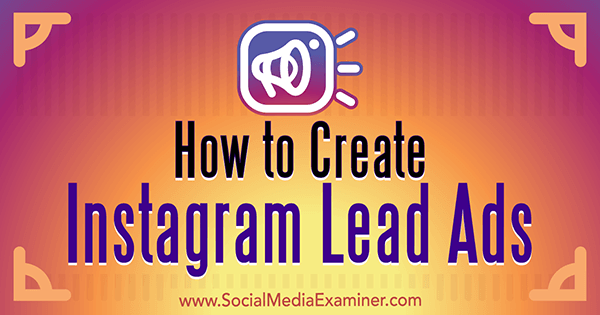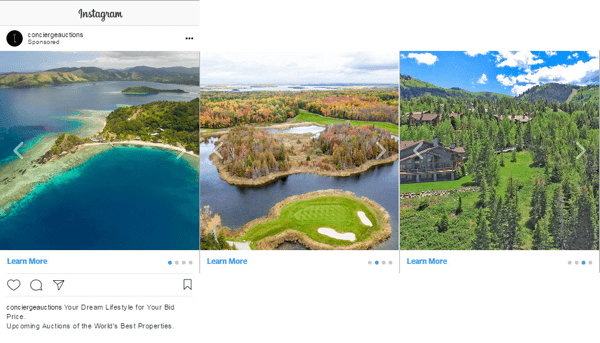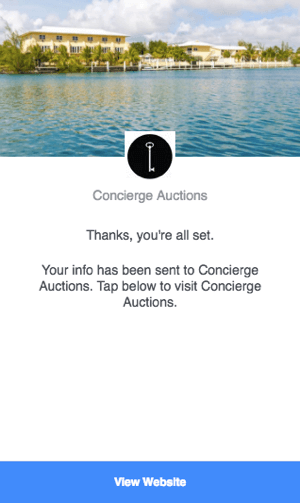 Do you advertise on Instagram?
Do you advertise on Instagram?
Want more leads?
Instagram lead ads let you collect valuable contact information from potential customers without pushing them off of the platform.
In this article, you'll discover how to set up lead ads on Instagram.

#1: Choose the Lead Generation Objective
To get started with lead ads, create a new ad campaign and select Lead Generation as the objective.

#2: Define Your Audience
Next, continue to ad set level to define your audience targeting. If you have existing lead/customer data, always use a lookalike audience. Upload your customer list to use as the source audience to build your lookalike audience.

Using your customer list as the source audience will give you better results than simply using existing leads from previous marketing efforts, which include people who have yet to drive any real value for your business. People who've actually spent money with your business (rather than just signaled interest) provide much stronger data for Facebook to work with.
It's even better if your customer base is large enough to segment out a portion of higher-value customers (e.g., repeat purchasers, high-spend purchasers, premium subscribers, etc.) to use as your lookalike source. Remember, though, Facebook recommends using a source audience of at least 1,000 users for best results.
Always exclude existing leads so you're not wasting impressions and ad dollars. By continuously retargeting the same users, you can stimulate negative feedback, which will deflate your relevance score and hurt your CPMs (cost per thousand impressions).
Facebook now lets you create an audience of users who successfully opened and submitted a lead form, so you can dynamically exclude incoming leads. With all other leads, you'll have to manually upload data to Facebook before excluding people.

#3: Select Your Ad Placement
Under Placements, select the Automatic Placements option, because that only includes the Facebook news feed and Instagram anyway. Audience network and all other Facebook placements are ineligible.

Although lead ads were originally rolled out just for mobile, Facebook realized that advertisers face all of the same obstacles on desktop too. Users are impatient, and making the process easier (by letting users submit their info in just a few taps) benefits both parties regardless of device. By selecting auto placement, your ads will be delivered on both desktop and mobile.
#4: Set Your Bid
In your bidding, make sure you optimize for leads vs. link clicks. Link clicks may result in a higher click-through rate but you should always optimize for what your true goal is, which is simply leads in this case.
Get World-Class Marketing Training — All Year Long!
Are you facing doubt, uncertainty, or overwhelm? The Social Media Marketing Society can help.
Each month, you’ll receive training from trusted marketing experts, covering everything from AI to organic social marketing. When you join, you’ll also get immediate access to:
- A library of 100+ marketing trainings
- A community of like-minded marketers
- Monthly online community meetups
- Relevant news and trends updates

#5: Choose an Ad Format
Now you're ready to move to the ad level. The front end of the ad unit is the standard format for regular ads, with the same creative options available.

Discover Proven Marketing Strategies and Tips
Want to go even deeper with your marketing? Check out the Social Media Marketing Podcast! Publishing weekly since 2012, the Social Media Marketing Podcast helps you navigate the constantly changing marketing jungle, with expert interviews from marketing pros.
But don’t let the name fool you. This show is about a lot more than just social media marketing. With over 600 episodes and millions of downloads each year, this show has been a trusted source for marketers for well over a decade.
A carousel ad that highlights the benefits of your service or product features/use cases can work nicely here. Incorporating testimonials and reviews is also a good idea. Although video works well, a slideshow can be an easier, cheaper alternative and Facebook provides simple tools for creating one.

#6: Create Your Lead Form
It's finally time to create your lead form! You should be thinking quality over quantity here.
To make sure your leads are qualified, always use a context card. The context card appears after users click on the ad and before they submit their information. This is where you lay out the benefits of submitting the form to your prospects. You can choose a paragraph or bullet point format for this card.
The following example uses bullet points to relay the main selling points to potential leads.

Keep questions to a minimum; less is more in this case. The user information fields, which consist of primary contact info along with some basic demographic and work information, will pre-fill with users' personal details as long as they've included them in their Facebook profile. This makes it easy for users to submit this information.
However, be careful not to include fields that aren't necessary, because users might be reluctant to hand over too much personal information this early in the relationship.
You can add up to three custom questions, but use these sparingly. If possible, ask multiple choice questions rather than open-ended questions. The more convenient the process, the more conversions you'll achieve.

If you're collecting customer information, you should already have a written privacy policy. Hopefully, it's posted on your website so you can provide a link to your privacy policy. This is a required field for creating the lead form.
Lastly, you can add a link to your website that users will see on the thank-you page along with a View Website call-to-action.

Want more like this? Explore Instagram for Business!
.
Conclusion
As Facebook's mobile ad inventory skyrockets, the platform is determined to make it easier for advertisers to generate value from mobile users. Introducing Instagram placement for lead ads is the latest example of this.
To get the most out of the leads you generate, make sure you follow up with them in a timely fashion. If you have a customer relationship management (CRM) system in place, you can set up your leads to sync automatically, so you can follow up as quickly as possible when the leads are most valuable. Manually downloading leads can result in a long lag between receiving a lead and following up with a prospect.
Facebook already supports many of the most popular CRM systems like Salesforce, MailChimp, and Zapier. You can find more information on the available integrations here. If you don't see yours listed, it might take some work by your developer to set up lead syncing through the Facebook API. Alternatively, you could use a middleman integration like LeadsBridge.
What do you think? Will you try Instagram lead ads? Please share your thoughts in the comments below.

Attention Agency Owners, Brand Marketers, and Consultants

Introducing the Marketing Agency Show–our newest podcast designed to explore the struggles of agency marketers.
Join show host and agency owner, Brooke Sellas, as she interviews agency marketers and digs deep into their biggest challenges. Explore topics like navigating rough economic times, leveraging AI, service diversification, client acquisition, and much more.
Just pull up your favorite podcast app, search for Marketing Agency Show and start listening. Or click the button below for more information.

